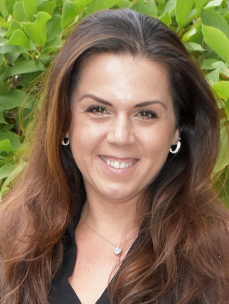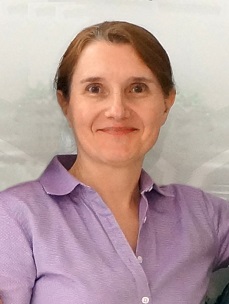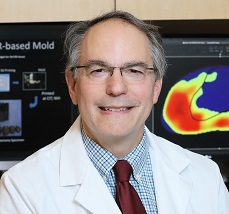Lecture Series
Center for Experimental Therapeutics Lecture Series
Talks spotlight researchers engaged in discovering and validating therapeutic targets, biomarkers, developing novel agents, and conducting clinical research. The series aims to advance innovation efforts and translate scientific discoveries into new effective therapies for cancer.
Watch our latest virtual event:
"Developing Early Detection and Therapeutic Strategies for Cancer"

Tanya Stoyanova, Ph.D.
Assistant Professor, Department of Radiology
Stanford University
Presented Thursday, Dec. 9, 2021 | 3-4 p.m.
Watch Dr. Stoyanova's presentation
Dr. Stoyanova focuses on understanding fundamental molecular mechanisms underlying the development of prostate and other epithelial cancers and their utility as biomarkers and therapeutic targets. Her laboratory aims to improve cancer early detection and aid the development of better therapeutic strategies for metastatic cancer.
Research in Dr. Stoyanova's laboratory has led to the discovery of new mechanisms underlying the development of aggressive prostate cancer and biomarkers for significant disease as well as new therapies for prostate and other epithelial cancers. She has received the Prostate Cancer Foundation Young Investigator Award, National Institutes of Health Pathway to Independence Award, Department of Defense Idea Development Award, Stanford McCormick and Gabilan Faculty Award and most recently, the National Institutes of Health/National Cancer Institute R37 MERIT Award and others.
Dr. Stoyanova received her doctorate in biochemistry and molecular genetics at the University of Illinois, Chicago in Dr. Pardip Raychaudhuri’s laboratory in July 2009, followed by a postdoctoral fellowship in prostate cancer biology at the University of California, Los Angeles in the laboratory of Dr. Owen Witte. In November 2015, Dr. Stoyanova joined the Department of Radiology and the Canary Center for Cancer Early Detection at Stanford University as an assistant professor.
Watch previous events:

Presented by Sandra Orsulic, Ph.D.
Professor in Residence, Obstetrics and Gynecology
UCLA David Geffen School of Medicine
Thursday, Nov. 18, 2021
Watch Dr. Orsulic's presentation
Cancer-associated fibroblasts (CAFs) can induce therapeutic resistance by blocking access of chemotherapies and immunotherapies and physically hindering the trafficking of functional immune cells to the tumor parenchyma. CAF-secreted transforming growth factor beta (TGFβ) is a potent cytokine that promotes pro-tumorigenic CAF and immune cell phenotypes.
Studies have shown that therapeutic efficacy can be drastically improved by co-administration of TGFβ-blocking agents. However, targeting TGFβ has been associated with toxicity, possibly because TGFβ is a pleiotropic cytokine expressed by multiple stromal cell types, some of which are required for normal tissue homeostasis. Less attention has been paid to another member of the TGFβ superfamily, Activin-A (encoded by the INHBA gene).
We showed that INHBA expression was restricted to CAFs and the normal placenta while other normal tissues did not express INHBA. Functional knockdown assays demonstrated that INHBA is important for the contraction, proliferation, and invasion of human ovarian CAFs in vitro.
In a syngeneic mouse model of ovarian cancer, suppression of INHBA expression in the host fibroblasts reduced tumor growth. Multiplex immunoassays demonstrated that metastatic tumors enriched for INHBA-positive CAFs were also enriched for regulatory T-cells (Tregs).
Co-culture experiments with human ovarian CAFs and naive T cells showed that Treg differentiation was dependent on direct contact with INHBA-expressing CAFs. Mechanistically, INHBA/recombinant Activin-A in CAFs induced autocrine expression of PD-L1 through SMAD2-dependent signaling, which promoted Treg differentiation. Considering the overlapping functions of Activin-A and TGFβ, targeting Activin-A may be an effective method to inhibit tumor progression without significant toxicity to normal tissues.

Presented by Peter L. Choyke, M.D., FACR
Head, Molecular Imaging Branch
Center for Cancer Research, National Cancer Institute
Thursday, Oct. 28, 2021 | 4-5 p.m.
Watch Dr. Choyke's presentation
Molecular imaging is a powerful technique that is increasingly used in drug discovery, development and clinical testing. During the drug discovery period, molecular imaging can be used for target discovery and optimization. During the development phase, imaging is used to better understand unexpected side effects and to further optimize the lead compound. During the testing phase it is commonly used for patient selection, pharmacodynamic assessment and as a readout of efficacy. At all stages, molecular imaging can help explain the properties of a new drug and improve understanding of its efficacy.
Dr. Choyke's research interests include the translation of molecular imaging methods, such as MRI, optical and radionuclide/PET into the clinic. His primary clinical focus is on imaging, diagnosis and therapy of prostate cancer. In the lab, Dr. Choyke focuses on understanding uptake of various PET agents, including PSMA, at the genomic level. In addition, his lab works on the development of new imaging methods for cancer including cell labeling with PET agents, and imaging the tumor microenvironment including immune markers.

Presented by Joseph C. Wu, M.D., Ph.D.
Director, Stanford Cardiovascular Institute
Simon H. Stertzer, M.D., Professor of Medicine and
Radiology, Stanford University
Thursday, Sept. 23, 2021 | 4-5 p.m.
Recent technological advancements in multi-omics, CRISPR genome editing, and human induced pluripotent stem cells have enabled the implementation of precision medicine on an individual patient level. Wu will discuss recent advances in these technologies and how they may be used for elucidating mechanisms of cardiovascular diseases, for understanding chemotherapy-induced cardiotoxicity, and for implementing “clinical trial in a dish” concept.
Wu's lab works on biological mechanisms of patient-specific and disease specific induced pluripotent stem cells (iPSCs). He uses a combination of stem cells, genomics, epigenetics, cellular and molecular biology, physiological testing, and molecular imaging technologies. His clinical interests involve adult congenital heart disease and cardiovascular imaging.
Wu has published more than 450 manuscripts with H-index of 108 on Google scholar. He received his medical degree from Yale University. Wu completed his medicine internship, residency and cardiology fellowship training at UCLA followed by a Ph.D. (molecular and medical pharmacology) in the UCLA STAR program.

Presented by Karin Rodland, Ph.D.
Laboratory Fellow
Integrated Omics Group
Pacific Northwest National Laboratory
Thursday, June 24, 2021 | 4-5 p.m.
Watch Dr. Rodland's presentation
Traditional approaches to biomarker discovery often generate long lists of differentially expressed genes between two different conditions, with little ability to distinguish between innate human variability and true disease-specific variation.
We have developed several proteomic approaches to deal with this problem, involving the use of targeted selected reaction monitoring mass spectrometry (SRM-MS) to rapidly identify robust differences in protein expression across multiple cohorts, using either tumor tissues or biofluids as the analyte.
Additionally, we have used longitudinal serum samples from the same individual over 4 to 6 year time spans to minimize the noise from human variability and detect early changes in serum biomarkers that may provide a significant margin for early detection.

Presented by Edward Chu, M.D., M.M.S.
Director, Albert Einstein Cancer Center
Vice President for Cancer Medicine, Montefiore Medicine
Professor of Medicine and of Molecular Pharmacology
Thursday, May 27, 2021 | 4-5 p.m.
PHY906 is a Chinese herbal medicine that has been used for nearly 2,000 years. This herbal medicine was selected based on the historical documentation in the Chinese literature of its use to treat a wide range of GI ailments, including diarrhea, nausea/vomiting, and abdominal cramps, as well as extensive preclinical and clinical data we have gathered in recent years on its potential efficacy and molecular mechanisms of this medicine.
While there had been extensive use of this herbal medicine, prior to our research, there was no product made under highly controlled and standardized methods nor had attempts been made to ensure quality control. With this in mind, our group focused our initial efforts on developing a rigorous standard operating procedure to produce cGMP material as well as develop highly sensitive chemical (LC-MS) and biological (gene expression) fingerprinting methodologies to ensure quality control and consistency of batch preparation.
Using high quality cGMP material that has been confirmed to be free of heavy metals and contaminants, we have conducted phase I and II clinical studies investigating the role of PHY906 as a modulator of irinotecan-based chemotherapy and have shown that it can reduce toxicity, maintain and even improve quality of life, and improve clinical efficacy.

Presented by Josef Penninger, M.D.
Director, Life Sciences Institute, University of British Columbia
Professor, Department of Medical Genetics, University of British Columbia
Professor of Genetics, University of Vienna
Thursday, April 22, 2021 | 4-5 p.m.
Watch Dr. Penninger's presentation
RANKL and RANK are expressed in a variety of cells and tissues throughout the body. They were originally described for their key roles in bone remodeling and
the immune system but have subsequently been shown to provide essential signals from regulating mammary gland homeostasis during pregnancy to
modulating tumorigenesis.
The success of RANKL/RANK research serves as a paragon for translational research from the laboratory to the bedside. Case in point has been the development of denusumab, a RANKL-blocking monoclonal antibody which has already helped millions of patients suffering from post-menopausal osteoporosis and skeletal related events in cancer.
I will provide an overview of the pathway from its origins to its clinical relevance in disease with a special focus on emerging evidence demonstrating the therapeutic value of targeting the RANKL-RANK pathway in cancer. Moreover, I will discuss evolutionary implications of the RANKL/RANK system and the role of the thymus in immunologic and metabolic control of pregnancy.

Presented by James H. Doroshow, M.D.
Deputy Director for Clinical and Translational Research
National Cancer Institute, NIH
Thursday, March 25, 2021 | 4-5 p.m.
Watch Dr. Doroshow's presentation
The NCI Patient Derived Models Repository was initiated with the assistance of NCI-designated Cancer Centers and NCORP sites 6 years ago; these investigators have provided over 3000 tumor and 2800 blood specimens that have been used to produce molecularly-characterized PDX (patient derived xenografts in NSG mice), PDOrg (patient derived organoid), PDC (patient derived 2D cell culture), and CAF (cancer associated fibroblast) models from a diverse group of clinically-annotated solid tumors.
The repository is now approaching its initial goal of having produced 1000 PDX models for distribution (at low cost) to the oncology community. Over 1500 models have been distributed to date to over half of all NCI Cancer Centers and to a wide range of biotech and pharma companies and other academic organizations; every sample has undergone WES, RNAseq, histologic characterization, and proof of tumorigenicity (for PDOrgs and PDCs) according to published SOPs.
These models have been used to demonstrate the genetic stability of PDXs over time (Nat. Genet. 53: 86-99, 2021), to develop novel methods for the propagation of organoids from rare tumor histologies, to define the prevalence of circulating tumor cells in PDX models with accompanying spontaneous metastases, and to develop new methods for the assessment of therapeutic efficacy in PDXs. Investigators are encouraged to query the PDMR website to determine whether any of the models currently available might be helpful for their research programs.

Presented by Brian Druker, M.D.
Director, OHSU Knight Cancer Institute
Thursday, Feb. 28, 2021 | 4-5 p.m.
Watch Dr. Druker's presentation
Imatinib (Gleevec) exemplifies the successful development of a rationally designed, molecularly targeted therapy for the treatment of a specific cancer. Imatinib is an inhibitor of the ABL, platelet-derived growth factor receptor, and KIT tyrosine kinases. Given the pathogenetic role of the BCR-ABL tyrosine kinase in chronic myeloid leukemia (CML), this was the first disease selected for clinical trials with imatinib.
The development of imatinib for CML will be briefly reviewed, from the identification of the BCR-ABL as the causative molecular event in CML to the clinical trials of imatinib. In patients with CML who acquire resistance to imatinib, mutations in the kinase domain of ABL are the most common mechanism of resistance and the development of second generation drugs targeting these mutations will also be reviewed.
Imatinib has now been successfully used in other malignancies driven by each of the targets of imatinib and the extension of imatinib to other diseases will be described. Lastly, the application of the paradigm of targeting molecular pathogenetic events in other cancers will be explored along with the ability to accelerate target identification and validating through data integration.
Questions?
We're here to help. Email our team.